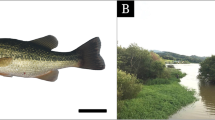Summary
The vestibulum is very short and lined by stratified squamous epithelium which contains many “alveolar” cells. The cavum nasi proprium is exceedingly complex, with three conchal formations and a series of six recesses and sinuses. Olfactory epithelium lines the whole dorsal or dorso-medial half of the cavum, but not the deep sinuses. Non sensory respiratory epithelium lines the ventral or ventro-lateral half of the cavum, all the caviconchal recess, the posterolateral recess, the postturbinal sinus, the postconchal cavity, and the nasopharyngeal duct. In olfactory epithelium the proportion of sensory cells is about 61 % inCrocodylus and 59 % inCaiman; the ratio of sensory cells to supporting cells is about 2.6/1 in the former and 1.8/1 in the latter. Bowman's glands are sero-mucous and normally developed. As in other reptiles, the respiratory epithelium is composed with mucous and ciliated cells; but, in ventrolateral part of the cavum, there are also sero-mucous cells forming small multicellular glands. The hypertrophied lachrymal duct constitutes a very large naso-lachrymal not previously described gland. The lumen is lined by mucous and ciliated cells, the collet of each branched tubular gland by mucous cells and the glandular tubes by sero-mucous cells. Adult crocodilians lack a Jacobson's organ and there are no vomeronasal sensory epithelium in the cavum.
In reptiles, aquatic way of life generally involves regression in olfactory epithelium, while Jacobson's organ (or, in Testudines, vomeronasal epithelium) persists and occasionally increases. In crocodilians, things are exactly reverse. After comparing with other Tetrapods, it seems likely that Jacobson's organ has been lost by terrestrial ancestor of crocodilians and birds. Now, only crocodilians posses olfactory epithelium, and naso-lachrymal gland gives them a supplementary protection, necessary in semiaquatic environment.
Similar content being viewed by others
Bibliographie
Barnett, R.J., Seligman, A.M.: Histochemical demonstration of protein-bound sulfhydryl groups. Sciences116, 323–327 (1952)
Bellairs, A. d'A., Boyd, J.D.: The lachrymal apparatus in lizards and snakes. I. The brille, the orbital glands, lachrymal canaliculi and origin of the lacrymal duct. Proc. Zool. Soc. Lond.117, 81–108 (1947)
Bellairs, A. d'A., Boyd, J.D.: The lachrymal apparatus in lizards and snakes. II. The anterior part of the lachrymal duct and its relationship with the palate and with the nasal and vomeronasal organs. Proc. Zool. Soc. Lond.120, 269–310 (1950)
Bellairs, A. d'A., Shute, C.C.D.: Observations on the narial musculature of Crocodilia and its innervation from the sympathetic system. J. Anat.87, 367–378 (1953)
Bertau, M.: Zur Entwicklungsgeschichte des Geruchsorgans der Krokodile. Z. Anat. Entwickl.-Gesch.104, 168–202 (1935)
Cowan, F.B.M.: The homology of cranial glands in turtles: with special reference to the nomenclature of “salt glands”. J. Morph.141, 157–170 (1973)
Dunson, W.A.: Somes aspects of electrolyte and water balance in three estuarine reptiles, the diamondback terrapin, American and “salt water” crocodiles. Comp. Biochem. Physiol.32, 161–174 (1970)
Dunson, W.A., Dunson, M.K.: Convergent evolution of sublingual salt glands in the marine file snake and the true sea snakes. J. comp. Physiol.86, 193–208 (1973)
Gabe, M., Saint Girons, H.: Données histologiques sur le tégument et les glandes épidermoÏdes céphaliques des Lépidosauriens. Acta Anat. Basel67, 571–594 (1967)
Gabe, M., Saint Girons, H.: Données histologiques sur les glandes salivaires des Lépidosauriens. Mém. Mus. Nat. Hist. Nat. A58, 1–112 (1969)
Gabe, M., Saint Girons, H.: Contribution à la morphologie comparée des fosses nasales et de leurs annexes chez les Lépidosauriens. Mém. Mus. Nat. Hist. Nat. A98, 1–87 (1976)
Kathariner, L.: Die Nase der im Wasser lebenden Schlangen als Luftweg und Geruchsorgan. Zool. Jb., Abt. Syst.13, 415–442 (1900)
Mowry, R.W.: Alcian blue technics for the histochemical study of acidic carbohydrates. J. Histochem. Cytochem.4, 407–408 (1956)
Neuhaus, W.: On the olfactory sense of birds. In: Olfaction and taste (Y. Zotterman, ed.), pp. 111–123. Oxford-London-New York-Paris: Pergamon Press 1963
Parsons, T.S.: Nasal anatomy and the phylogeny of reptiles. Evolution13, 175–187 (1959)
Parsons, T.S.: Evolution of the nasal structure in the lower tetrapods. Am. Zool.7, 397–413 (1967)
Parsons, T.S.: The nose. In: Biology of the Reptilia, Vol. 2 (C. Gans, ed.), pp. 99–191. London-New York: Academic Press 1970
Parsons, T.S.: Nasal anatomy of trionychid turtles. J. Morph.135, 323–334 (1971)
Pearse, A.G.E.: Histochemistry. London: Churchill 1960
Rathke, H.: Untersuchungen über die Entwicklung und den Körperbau der Krokodile. Braunschweig: Vieweg 1866
Ravetto, C.: Alcian blue-alcian yellow: a new method for the identification of different acidic groups. J. Histochem. Cytochem.12, 44–45 (1964)
Reese, A.M.: The cephalic glands ofAlligator mississippiensis, Florida alligator, and ofAgkistrodon, copperhead and moccasin. Biologia gen.1, 482–500 (1925)
Saint Girons, H.: Développement respectif de l'épithélium sensoriel du cavum et de l'organe de Jacobson chez les Lépidosauriens. C. R. Acad. Sc. Paris280, 721–724 (1975)
Seydel, O.: über die Nasenhöhle und das Jacobson'sche Organ der Amphibien. Morph. Jb.23, 453–543 (1895)
von Wettstein, O.: Sauropsida: Allgemeines-Reptilia. In: Handbuch der Zoologie, Bd. VII (W. Kükenthal et al., Hrsg.), S. 321–424. Berlin: de Gruyter 1954
Author information
Authors and Affiliations
Rights and permissions
About this article
Cite this article
Saint Girons, H. Données histologiques sur les fosses nasales et leurs annexes chezCrocodylus niloticus Laurenti etCaiman crocodilus (Linnaeus) (Reptilia, Crocodylidae). Zoomorphologie 84, 301–318 (1976). https://doi.org/10.1007/BF01578698
Received:
Issue Date:
DOI: https://doi.org/10.1007/BF01578698




